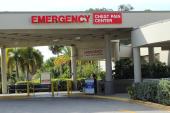CT Angiography Is Increasing in England, but Downstream Tests Are Not
Additionally, researchers tied the rise in CCTA to reduced CV deaths, with higher-use regions having better outcomes.

Ever since the National Institute for Health and Care Excellence (NICE) gave priority to coronary computed tomography angiography (CCTA) as the test of choice for patients presenting with recent-onset chest pain, use of the imaging modality has been on the rise.
That increase, however, has not been offset by more downstream testing, such as invasive angiography, nor was it linked with any significant costs to the healthcare system.
Additionally, researchers observed an associated reduction in deaths from cardiovascular and ischemic causes, as well as a trend toward lower all-cause mortality, in areas with the largest regional increases CCTA use.
“The more cardiac CT you use, the less cardiovascular death you have,” senior investigator Edward D. Nicol, MD (King’s College London, England), told TCTMD. “The effect of all-cause mortality is interesting, but I think we have to say that biologically, plausibly, I don’t think we can fully explain that reduction. It’s really the reduction in cardiovascular deaths and hospitalizations that’s the key piece here.”
In 2016, NICE recommended CCTA as the first-line investigation for patients with stable chest pain with typical or atypical symptoms, as well as those with nonanginal chest pain with ECG changes suggestive of coronary artery disease. Based on that guideline, noninvasive functional imaging should only be used if CCTA showed coronary artery disease of uncertain functional significance. NICE also stated that invasive coronary angiography should be third in line for situations where results of noninvasive imaging are inconclusive.
The NICE recommendations are a bit of an outlier—no other professional body has given such a prominent role to CCTA. In the US guidelines, CCTA is a class 1 recommendation for intermediate-risk patients, but other imaging tests also have class 1 recommendations for diagnosing vessel-specific ischemia or to aid clinical decisions. The European Society of Cardiology takes a similar approach to investigating CAD.
“I think what this study does is prove that NICE was right,” said Nicol. “Cardiac CT [angiography] is the most cost-effective model. The cost here has remained neutral, and the effect is clear. Unlike SCOT-HEART, we’re talking about 2 million people. It’s not a 5,000-patient study [like SCOT-HEART], nor 10,000 patients in PROMISE. This is real-world UK data over a 7-year period—it’s a data set that couldn’t be more consistent.”
Use of Invasive Angiography Trends Downward
In the present study, which was led by Jonathan Weir-McCall, PhD (University of Cambridge, England), and published this week in JACC: Cardiovascular Imaging, the researchers wanted to assess the impact of the NICE recommendations. To TCTMD, Nicol said that when the guidelines came out, there was concern that more use of CCTA would lead to increased invasive and noninvasive downstream testing. As a result, the cost-effectiveness of CCTA—which is cheaper than SPECT and invasive angiography—wouldn’t work, he said.
Researchers analyzed data from the National Health Service (NHS) of all patients undergoing imaging tests in England. They also linked the use of cardiac imaging in the NHS with hospital admission and mortality data from two patient-level databases.
The valid concern that doing more CT would mean you’re just going to do a lot more invasive angiography is not borne out by this data. Edward D. Nicol
Between 2012 and 2018, a total of 1,909,314 investigations for CAD were performed. Overall, there was consistent growth in the use of cardiac imaging, with an annualized per capita growth rate of 4.8%. Invasive coronary angiography remained the most commonly used imaging modality with 214.5 angiograms/100,000 people per year and an annual growth rate of 2.3%. SPECT was the second most commonly used imaging modality, with an average of 151.7 tests/100,000 people per year, but its use declined 3.2% annually during the study period. CCTA was the third most commonly used test (84.6 CCTA/100,000 people per year), but it had the highest annual growth rate at 15.7%.
Before the NICE recommendations came out in 2016, use of invasive angiography was on the rise in England, with an increase of 0.02 angiograms/100,000 people per month. After the NICE guidelines, though, that growth stopped and appeared to decline, down by 0.06 angiograms/100,000 people per month. Use of SPECT was declining both before and after the NICE guidelines. On the other hand, CCTA use increased before the 2016 recommendations and then picked up substantially after the guidelines came out (0.19 CCTA/100,000 per month).
“The valid concern that doing more CT would mean you’re just going to do a lot more invasive angiography is not borne out by this data,” said Nicol.
He added that the decline in invasive angiography over the study period is not quite significant, but there is a strong signal that use is going down. Anecdotally, many hospitals have now purchased CT scanners and are providing cardiac CT services, Nicol said. “Invasive angiography is increasingly being used for procedures where they would put a stent in or there is a reason why they can’t do the CT scan.”
Across England’s 42 different regions, there was a trend toward an inverse association between the growth rates of CCTA and invasive angiography, but the association wasn’t statistically significant.
Effect on Outcomes
Overall, there was no association between any region’s growing use of CCTA and hospital admissions, but CCTA growth was linked to a reduction in cardiovascular deaths and ischemic heart disease deaths. Regions in England with the largest growth in CCTA saw the largest declines in cardiovascular mortality, as well as a larger fall in all-cause mortality. Greater regional increases in CCTA were also associated with fewer hospitalizations for MI.
The reduction in death/MI in SCOTHEART proved to be one of the most contentious findings in that trial, with critics protesting that a change in screening methods couldn’t be credited with reducing hard events, a complaint the SCOTHEART investigators later tackled head-on with an analysis explaining how that might occur.
Interesting trends, but to link reduced CV outcomes to increased use of CTCA based on this study is a bit of a stretch!
— Sanjay Kaul (@kaulcsmc) January 12, 2023
Sanjay Kaul, MD (Cedars-Sinai Medical Center, Los Angeles, CA), for one, published a viewpoint in JAMA in 2019 questioning the strength of evidence supporting CCTA as the noninvasive test of choice for patients with stable chest pain, arguing the findings from SCOT-HEART weren’t robust enough to justify it. This week, on Twitter, he called the new imaging trends interesting, but thinks the link with cardiovascular outcomes is “bit of a stretch.”
Nicol, on the other hand, believes CCTA leads to a drop in cardiovascular deaths because it allows clinicians to “put the right people on the right treatment,” including statins for primary prevention. As a result, there’s a downstream benefit because people are treated appropriately.
And, while it might also send more people on for coronary revascularization, “it’s the right people that needed revascularizing,” he added.
Of note, although the use of imaging is increasing in England, the costs observed in this study—average annual healthcare spending on coronary imaging was £214 million—remained stable. Costs increased by £0.35 million/100,000 people per year, an increase of 2.8%, which is in line with inflation.
“There’s been essentially no cost increase, but a lot more tests, because you’ve replaced expensive tests, predominantly invasive coronary angiography, with cheaper tests, predominantly coronary CT angiography,” said Nicol. “If you go back to NICE’s principles [of] cost-effectiveness, the cost bit is justified, and if we talk about effectiveness, what we do see is a statistical reduction in cardiovascular death between those areas that most use cardiovascular CT versus those that had the least increase in cardiovascular CT.”
One of the limitations of the analysis is that it only captures imaging tests performed to 2018, but the COVID-19 pandemic didn’t allow researchers to proceed beyond that time. “We’re planning in the future to rerun the data set in a couple years to understand the impact of COVID and how did [imaging] bounce back,” he said. “It’s going to be messy because COVID was obviously associated with cardiovascular mortality, but we will have that opportunity going forward.”
Michael O’Riordan is the Managing Editor for TCTMD. He completed his undergraduate degrees at Queen’s University in Kingston, ON, and…
Read Full BioSources
Weir-McCall JR, Williams MC, Shah ASV, et al. National trends in coronary artery disease imaging: association with health care outcomes and costs. J Am Coll Cardiol Img. 2023;Epub ahead of print.
Disclosures
- Nicol reports no relevant conflicts of interest.





Comments